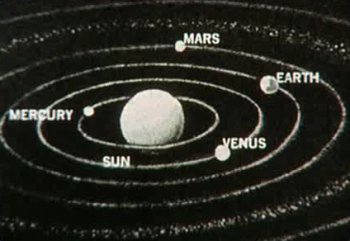Difference between revisions of "Venus (FASA)"
| Line 8: | Line 8: | ||
Venus was the second planet in the [[Sol system]]. Information on Venus, as well as the rest of the [[Sol system]], was obtained by the [[Talosians (FASA)|Talosians]] when they accessed the [[U.S.S. Enterprise NCC-1701 (FASA)|U.S.S. ''Enterprise'' NCC-1701]] [[computer]]<ref name="TOS00"/> in [[FASA Chronology: 2196|2196]].<ref name="FASA2004A"/> | Venus was the second planet in the [[Sol system]]. Information on Venus, as well as the rest of the [[Sol system]], was obtained by the [[Talosians (FASA)|Talosians]] when they accessed the [[U.S.S. Enterprise NCC-1701 (FASA)|U.S.S. ''Enterprise'' NCC-1701]] [[computer]]<ref name="TOS00"/> in [[FASA Chronology: 2196|2196]].<ref name="FASA2004A"/> | ||
| − | Exploration of Venus began in [[1970s (FASA)#1978|1978]] with the landing of ten probes, which were sent to gather as much information about the planet as possible, to aid in [[Humans (FASA)|humanity]]'s understanding of the planet's atmospheric composition and the internal mass distribution. The [[Venus Terraforming Project (FASA)|Venus Terraforming Project]] was given the green light in [[2020s (FASA)#2024|2024]], following several years of scientific studies. Terraforming began in [[2020s (FASA)#2027|2027]], when the [[DY-500 class (FASA)|DY-500 class]] [[U.N.S.S. Tiller (FASA)|U.N.S.S. ''Tiller'']] seeded the atmosphere with the algae Cyanidium Caladarium. The project continued for several decades, slowly reshaping the planet's atmospheric composition. In [[2040s (FASA)#2046|2046]], the [[Venus Flyer (FASA)|Venus Flyer]] entered service: a variable wing aircraft designed to assist in the ongoing Venus Terraforming Project, and a base was constructed at the planet's north pole, allowing for project scientists to maintain a permanent presence on the planet for the first time.<ref name="SFC"/> | + | Exploration of Venus began in [[1970s (FASA)#1978|1978]] with the landing of ten probes, which were sent to gather as much information about the planet as possible, to aid in [[Humans (FASA)|humanity]]'s understanding of the planet's atmospheric composition and the internal mass distribution. In [[1980s (FASA)#1983|1983]], the [[Venus Atmospheric Balloon (FASA)|Venus Atmospheric Balloon]] entered the Venusian atmosphere, sending back data from its gondola of scientific instruments; it circled the planet on the stratospheric winds for several days. The [[Venus Terraforming Project (FASA)|Venus Terraforming Project]] was given the green light in [[2020s (FASA)#2024|2024]], following several years of scientific studies. Terraforming began in [[2020s (FASA)#2027|2027]], when the [[DY-500 class (FASA)|DY-500 class]] [[U.N.S.S. Tiller (FASA)|U.N.S.S. ''Tiller'']] seeded the atmosphere with the algae Cyanidium Caladarium. The project continued for several decades, slowly reshaping the planet's atmospheric composition. In [[2040s (FASA)#2046|2046]], the [[Venus Flyer (FASA)|Venus Flyer]] entered service: a variable wing aircraft designed to assist in the ongoing Venus Terraforming Project, and a base was constructed at the planet's north pole, allowing for project scientists to maintain a permanent presence on the planet for the first time.<ref name="SFC"/> |
By [[Reference Stardate]] [[2223 (FASA)#June|2/2306 (June 2223)]], Venus supported a population of 2.57 billion people and was a member of the [[United Federation of Planets (FASA)|United Federation of Planets]] in its own right. By 2223, Venusian shipyard facilities produced an average of 12 assault ships, 14 cruisers, 8 frigates, and 95 [[warp drive (FASA)|warp]] shuttles and courier ships per year.<ref name="FASA2011"/> | By [[Reference Stardate]] [[2223 (FASA)#June|2/2306 (June 2223)]], Venus supported a population of 2.57 billion people and was a member of the [[United Federation of Planets (FASA)|United Federation of Planets]] in its own right. By 2223, Venusian shipyard facilities produced an average of 12 assault ships, 14 cruisers, 8 frigates, and 95 [[warp drive (FASA)|warp]] shuttles and courier ships per year.<ref name="FASA2011"/> | ||
Revision as of 00:47, 25 April 2021
| Coordinates | 23.9, 61.8, 0.0[1] |
| Affiliation | Member,[2] United Federation of Planets[3] |
| Planetary Class | M (Terraformed from[4] C[5] |
| Advertising |
Venus was the second planet in the Sol system. Information on Venus, as well as the rest of the Sol system, was obtained by the Talosians when they accessed the U.S.S. Enterprise NCC-1701 computer[3] in 2196.[6]
Exploration of Venus began in 1978 with the landing of ten probes, which were sent to gather as much information about the planet as possible, to aid in humanity's understanding of the planet's atmospheric composition and the internal mass distribution. In 1983, the Venus Atmospheric Balloon entered the Venusian atmosphere, sending back data from its gondola of scientific instruments; it circled the planet on the stratospheric winds for several days. The Venus Terraforming Project was given the green light in 2024, following several years of scientific studies. Terraforming began in 2027, when the DY-500 class U.N.S.S. Tiller seeded the atmosphere with the algae Cyanidium Caladarium. The project continued for several decades, slowly reshaping the planet's atmospheric composition. In 2046, the Venus Flyer entered service: a variable wing aircraft designed to assist in the ongoing Venus Terraforming Project, and a base was constructed at the planet's north pole, allowing for project scientists to maintain a permanent presence on the planet for the first time.[4]
By Reference Stardate 2/2306 (June 2223), Venus supported a population of 2.57 billion people and was a member of the United Federation of Planets in its own right. By 2223, Venusian shipyard facilities produced an average of 12 assault ships, 14 cruisers, 8 frigates, and 95 warp shuttles and courier ships per year.[2]
Notes and References
- ↑ Maynard, Jeff (Author). Star Trek Maps. Star Trek. Book. Bantam Books. August 1980.
- ↑ 2.0 2.1 Menke, Bernard Edward and Rick David Stuart (Authors). The Federation. Star Trek: The Role Playing Game. Book 2011. Cover art by David R. Deitrick. Illustrations by Todd F. Marsh, John C. Tylk, Bob Eggleton, Daniel E. Carroll, and Jay Harris. FASA Corporation. 1986.
- ↑ 3.0 3.1 Template:RefTOS00
- ↑ 4.0 4.1 Goldstein, Stan et al (Authors). Spaceflight Chronology. Star Trek. Book. Wallaby Books. 1980.
- ↑ Johnson, Shane. Star Trek: The Worlds of the Federation. Pocket Books, 1989.
- ↑ Wheeler, Wm. John et al (Authors). Cadet's Orientation Sourcebook. Star Trek: The Role Playing Game. Book 2004A, Second Edition. Cover art by Rowena. Graphics and layout by Dana Knutson and Jordan Weisman. FASA Corporation. 1983.

